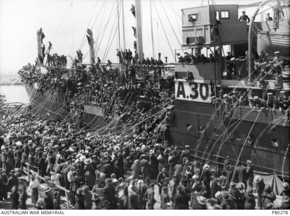
705
FERGUSON, Howard Chapman
| Service Number: | 2144 |
|---|---|
| Enlisted: | 10 February 1915, at Keswick |
| Last Rank: | Private |
| Last Unit: | 50th Infantry Battalion |
| Born: | Gawler, South Australia, Australia, April 1894 |
| Home Town: | Adelaide, South Australia |
| Schooling: | Not yet discovered |
| Occupation: | Labourer |
| Died: | Kilburn, 25 February 1957, cause of death not yet discovered |
| Cemetery: |
West Terrace Cemetery (AIF Section) Section: KO, Road: 21A, Site No: 16 |
| Memorials: |
World War 1 Service
| 10 Feb 1915: | Enlisted AIF WW1, Private, 2144, 10th Infantry Battalion, at Keswick | |
|---|---|---|
| 23 Jun 1915: | Involvement Private, 2144, 10th Infantry Battalion, --- :embarkation_roll: roll_number: '10' embarkation_place: Adelaide embarkation_ship: HMAT Borda embarkation_ship_number: A30 public_note: '' | |
| 23 Jun 1915: | Embarked Private, 2144, 10th Infantry Battalion, HMAT Borda, Adelaide | |
| 16 Aug 1916: | Wounded AIF WW1, Private, 2144, 50th Infantry Battalion, Mouquet Farm, GSW shoulder | |
| 11 Nov 1918: | Involvement Private, 2144, 50th Infantry Battalion |
Help us honour Howard Chapman Ferguson's service by contributing information, stories, and images so that they can be preserved for future generations.
Add my storyBiography contributed by St Ignatius' College
Howard Chapman Ferguson was born in the town of Gawler in South Australia sometime in approximately April 1894. Before the war, he lived at 94 Sturt Street, Adelaide, South Australia. His occupation was a labourer before fighting in the war, an unskilled worker who does manual labour. The war was his first involvement in the military force. He was married before the war to Lillian Ferguson and had one child. The Church of England was his religion. Ferguson enlisted for the Australian Imperial Force on the 10th of February 1915. The first ship he boarded was the HMAT A30 Borda on June 23rd, 1915 as part of the 10th Infantry Battalion. The ship departed from Adelaide and arrived in Egypt. Ferguson landed on Gallipoli and joined the 10th battalion on 4th August 1915.
On 28th August he was evacuated off the peninsula and taken to Egypt with dysentery. He probably returned to Gallipoli in October but in mid November was hospitalised again with an infection. Towards the end of 1915, the Gallipoli campaign was deemed unsuccessful. His battalion along with others were evacuating into northern Egypt around the city of Cairo. After some reconfiguration and the birth of the 50th Battalion, he had been taken on strength and on the 2nd of April 1916 he was now a part of the 50th Infantry Battalion.
As part of this, he was transported to France to the village of Pozieres on June 11th , 1916. His battalion wasn’t in the front line until the middle of August when the second phase of fighting started. Whilst fighting at Mouquet Farm near the location of the other battle in Pozieres. Whilst fighting in this battle, he was the victim of shelling as well as many other members of the battalion. He was injured on the 16th of August 1916 because of this, in the shoulder. He was taken to England for treatment and, although the wound was classed as slight, he remained in England through most of 1917. On 21st December 1917 he was put on a boat back to Australia for discharge: the lingering effect of his shoulder wound and what is listed on his record as defective vision.
After the war Howard Chapman Ferguson returned to Australia on the 21st of December 1917. He returned to his family and presumably resumed working as a labourer, a low skilled worker generally somewhere in the construction industry. He was always married to his wife Lillian Ferguson until his death on the 25th of February 1957 at the age of 62 years old.











